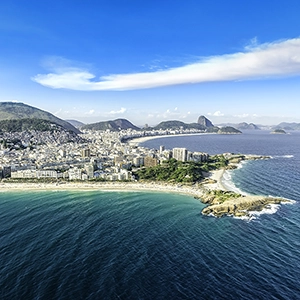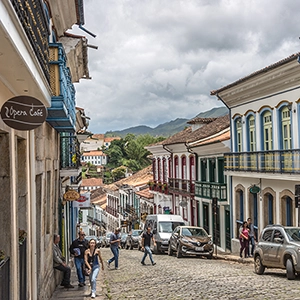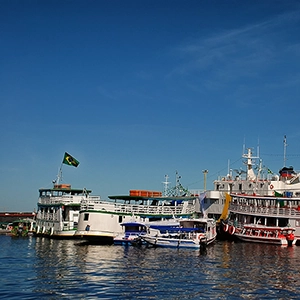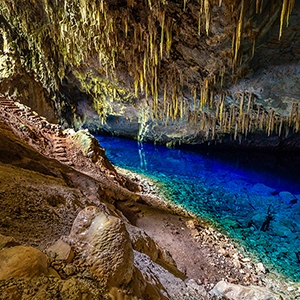Experience The Exhilarating Iguazu Falls, Shared With Argentina

The Iguazu Falls, known as one of the world's most stunning wonders, is a breathtaking spectacle of natural beauty worth traveling for. Shared by Argentina and Brazil, the falls offer a variety of shifting perspectives and captivating sights that will leave visitors spellbound. Experience the overwhelming power and majesty of one of the planet's most impressive creations by following along as we explore the Iguazu Falls from both sides of the border.
History and Cultural Background
In the local Guarani tribal language, Iguazu means "big water." Legend has it that the falls were created when a snake god punished the tribespeople for taking a forbidden lover by splitting the river into separate falls, thus creating Iguazu Falls. Today, the falls are considered sacred by the Guarani people, and care is taken to preserve their cultural significance and natural beauty.
In 1541, Spanish explorer and conquistador Álvar Núñez Cabeza de Vaca became the first European to stumble upon the Iguazu Falls. After centuries of obscurity, the falls returned to the world's attention and began to draw tourists from around the globe. In 1984, UNESCO declared Iguazu Falls a World Heritage site, recognizing its importance in ecological preservation and international tourism.
Geographical Overview of Iguazu Falls
Iguazu Falls is located in the Iguazu River and forms part of the border between Argentina and Brazil. The river begins in Brazil, winding through Paraguay, and ending in Argentina, where it meets the Paraná River. The falls consist of nearly 275 individual cascades and are staggered over several kilometers, reaching their apex on the Argentine side at the famous Garganta del Diablo or Devil's Throat, a massive U-shaped cascade more than 80 meters in height.
The stunning breadth of the falls is truly impressive, spanning 2.7 kilometers (1.7 miles) wide with the highest drop of 82 meters (269 feet). The water volume of Iguazu Falls varies drastically depending on rainfall, ranging from 1000 to 45,000 cubic meters per second. The falls originate from a volcanic fault and are surrounded by lush subtropical rainforests, creating a unique and enchanting landscape unlike anywhere else in the world.
How to Experience Iguazu Falls from the Argentine Side
The Argentine side offers a more extensive and immersive experience of the falls, owing to its greater share of the cascades and its well-developed network of walkways, bridges, and viewpoints. Iguazu National Park, located around 17 kilometers (10.5 miles) from the town of Puerto Iguazu, is home to two-thirds of the falls.
The park is divided into three main circuits: the Upper Circuit, the Lower Circuit, and the highly coveted Devil's Throat. The Upper Circuit allows visitors to appreciate the falls from above, while the Lower Circuit offers a different viewpoint from below and up close. The Devil's Throat is accessed via a small train service that takes visitors to the emblematic and thunderous cascade, where they can walk along the edge and thrill to the sound of crashing waters.
For the more adventurous, the park also offers guided boat tours that pass underneath the falls for some heart-pounding excitement. Eco-tourism options include bird-watching tours, mountain biking routes, and nature walks that bring visitors closer to the region's diverse flora and fauna.
How to Experience Iguazu Falls from the Brazilian Side
While the Brazilian side of Iguazu Falls is smaller, it offers a unique and equally mesmerizing view of the cascades. The less extensive network of viewing platforms ensures that visitors get a panoramic view of the entirety of the falls, making the Brazilian side arguably more photogenic. The Brazilian side also boasts the thrilling Macuco Safari, a boat trip that takes visitors right up to the base of the powerful falls.
Aside from viewing the falls, the Brazilian side of the Iguazu River hosts the Parque das Aves or Bird Park. This expansive aviary features hundreds of bird species, providing visitors with a heightened appreciation for the region's diverse wildlife. Protected jaguars can also be observed in the park, offering a unique contrast to the feathered residents of the aviary.
Traveling to Iguazu Falls
Visitors can access the falls by flying into either Foz do Iguaçu International Airport (Brazil) or Cataratas del Iguazú International Airport (Argentina). Both airports are just a short distance from the national parks that surround the falls. Travelers should ensure they have the appropriate visa or travel permit for entry into both countries, as some nationalities are subject to entry requirements.
While the falls themselves are the main draw for many travelers, the region offers exciting opportunities for exploration beyond the park's boundaries. Both Puerto Iguazu (Argentina) and Foz do Iguaçu (Brazil) are bustling tourist towns, with plenty of restaurants, accommodations, and activities to help make the most of a trip to this stunning region.
Iguazu Falls presents an opportunity for travelers to witness the awe-inspiring power and beauty of one of nature's most incredible creations. Whether experienced from the Argentine or Brazilian side, the falls will leave visitors with unforgettable memories of the jaw-dropping scale of this natural marvel. A visit to Iguazu Falls promises to be an exhilarating adventure, as visitors explore the cascades and their surrounding subtropical rainforests, providing unparalleled connection with the beauty and magic of the natural world.









